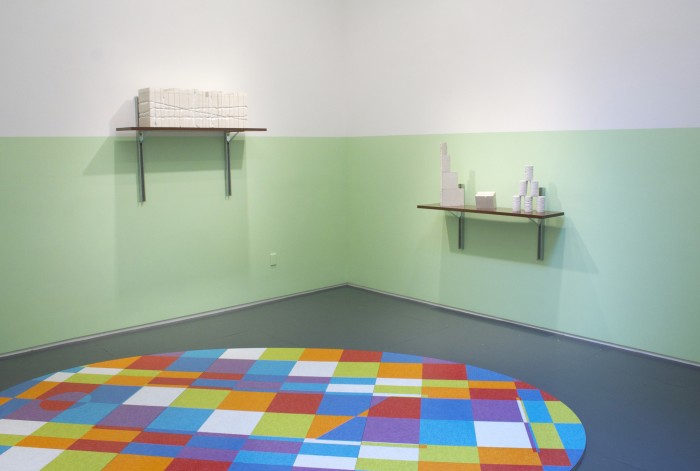David Scanavino, installation at Klaus von Nichtssagend Gallery, 2013
David Scanavino set the terms for his subtly slippery practice in 2005 with two drawings he showed at Klaus von Nichtssagend Gallery in New York. The minimal gray form that sits like an ominous slug against the crinkled black background of Desk with Scribbles is really a depiction of a standard- issue school desk; Fluorescent Light Desk verges on text art, because by turning the desk shape over and removing its perspectival slant, Scanavino has made it resemble an open quotation mark.
The artist plumbs the endlessly rich distinction between positive and negative space with four 2008 sculptures–each called untitled (eight foot rope). These works consist of plaster slabs imprinted with the length of rope in shapes resembling an aqueduct, Jacob’s ladder, the Tower of Babel, and a curved fin that rises from the floor like the blade of a table saw. He has applied newspaper pulp directly to the wall and blurred the border between artwork and gallery decor with deceptively unremarkable tile flooring. Untitled (one square foot), 2008, a cube of linoleum tile, sits unobtrusively on a floor covered in similar 12-inch-square gray tiles, at once carrying the space-defining quality of its material to an unusual extreme and subverting the tile by altering its context. Candy Crush (2014), a multicolored, 88-foot-long tile floor that bends up the wall, recently installed at the Pulitzer Foundation for the Arts in St. Louis, slipped away from sculpture in a different direction, serving as the stage for multiple performances.
Tiles, paper pulp, rope marks (now in gypsum cement)—Scanavino’s materials have become a fully realized vernacular in which art historical references and conceptual questioning, while both still fully present, are surpassed by aesthetic pleasure.
